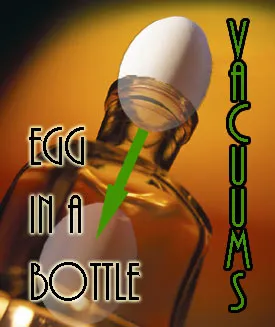 The Teacher's Corner
The Teacher's Corner
Air Pressure and Vacuums Experiment
Egg in a Bottle
The experiment for this week is another classic, but a very misunderstood one. You will even find that many books of science experiments get this one wrong.
You will need:
- a hard boiled egg
- a wine carafe or bottle with a neck that is just a little too small for
- the egg to fit through
- a piece of paper
- matches or a lighter
Warning: This experiment uses fire, so be careful and follow all safety procedures. Never do fire experiments when you are alone, even if you are an adult. If you are not an adult, then at least one of the people with you should be an adult. Think through the experiment before you try it, to be sure that everything you do is safe.
 For this experiment, we are going to put a hard boiled egg into the bottle. First, you need a hard boiled egg. Let it cool and carefully remove the shell. Be sure not to damage the egg, as this will keep the experiment from working properly. If you accidentally tear your hard boiled egg, put it in a bowl and chop it with a little mayonnaise or salad dressing. It makes a nice snack while you are boiling another egg.
For this experiment, we are going to put a hard boiled egg into the bottle. First, you need a hard boiled egg. Let it cool and carefully remove the shell. Be sure not to damage the egg, as this will keep the experiment from working properly. If you accidentally tear your hard boiled egg, put it in a bowl and chop it with a little mayonnaise or salad dressing. It makes a nice snack while you are boiling another egg.
Once you get the egg peeled, then you have to put it in the bottle. Gently place it on the top of the bottle. Not much happens. It just sits there. If you tried to push the egg into the bottle with your fingers, the egg would tear. We want the egg to be whole when it is inside the bottle. How are we going to do it?
We will start by removing the egg from the top of the bottle. CAREFULLY hold a piece of paper about one inch wide and three inches long. While you are holding one end, use the match to light the other end. As soon as it is burning, drop it into the bottle and quickly place the egg on top. Watch carefully what happens.
The paper burns for a second or two. As the fire goes out, the egg begins to move downwards into the bottle. It squeezes through the neck and drops into the bottle. How did that happen?
Most books will tell you that the paper burned up the oxygen, lowering the air pressure inside the bottle, and that the greater air pressure on the outside of the bottle pushed the egg inside. They get the part about the air pressure right, but the lowered pressure in the bottle is not due to burning up the oxygen.
When you burn paper in oxygen, the carbon in the paper combines with oxygen in the air to form a new gas called carbon dioxide. This gas takes up about as much space as the oxygen, so the burned oxygen is replace with carbon dioxide and the pressure in the bottle stays the same.
But if the egg was pushed into the bottle by air pressure, what lowered the pressure in the bottle? The answer is temperature. While the paper was burning, it heated the air in the bottle. The heating air expanded and pushed out past the egg. If you put the egg on the bottle quickly and watch carefully, you may be able to see the egg shake as the air rushes out past it. As the flame begins to die down, the air inside the bottle cools. As it cools, it gets smaller, reducing the pressure in the bottle. The egg acts as a cork, sealing the top of the bottle to keep air from coming in to balance the pressure. Instead, the higher outside pressure pushes the egg into the bottle.
Now, how do we get the egg out of the bottle? One way is to turn the bottle upside down, with the egg resting in the neck of the bottle. Put your mouth against the mouth of the bottle and blow as hard as you can. This increases the pressure inside the bottle. Quickly move the bottle away from your mouth and the egg should pop out. Rinse off the carbon from the burned paper and your egg is now ready for snack time.
All lessons are brought to you by The Teacher's Corner and Robert Krampf's Science Education Company.
Robert Krampf's Science Shows thehappyscientist.com
